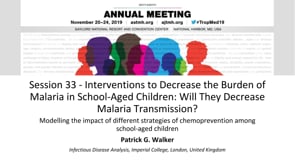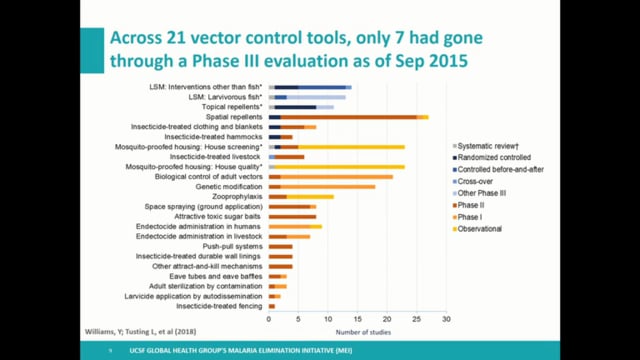6th International Conference on Plasmodium vivax Research (ICPvR) – 2017: Day 4
Wednesday, 14th June 2017
Published: 10/12/2018
This report is brought to you by the MESA Correspondents Rosalind Howes, and Hernando del Portillo.
MESA Correspondents bring you cutting-edge coverage from the 6th International Conference on Plasmodium vivax Research
Day 4: Final scientific sessions & Krotoski closing lecture
Topic 9: Are current control strategies aimed at P. vivax working?
This morning’s opening session was focussed on diagnostics for P. vivax parasitaemia and G6PDd. Ingrid Felger discussed the pros and cons of available high-sensitivity diagnostics, which differ in suitability depending on the diagnostic objective: e.g. maximising detection sensitivity vs. quantifying parasitaemia. She discussed the negligible benefit of gametocyte detection for programmatic surveillance and the trade-off between false-positives and increased sensitivity, urging a conservative approach to avoid potentially alarmist results. Iveth Gonzalez (FIND) discussed refinements to RDT diagnostics, including a new combination RDT for P. falciparum and P. vivax currently in development. She emphasised that improved diagnosis requires not only technological innovation, but also increased patient access to treatment in terms of treatment-seeking behaviour and test availability. Anna Rosanas-Urgell demonstrated the operational feasibility of mobile LAMP-based detection of asymptomatic infections using pop-up laboratories in remote Amazonian riverine communities near Iquitos.
Kevin Baird presented on behalf of Ari Satyagraha a study of G6PDd in 2056 females from Sumba, Indonesia. Almost all females with <70% enzyme activity were heterozygote G6PDd with a range of variants. Qualitative diagnostics set to the routine threshold of 30% residual activity would fail to identify most heterozygotes. David Sebba (industry representative from BD) presented a hand-size portable diagnostic device that provides rapid, temperature-corrected, quantitative measures of G6PD activity and Hb levels. Tight correlation with the Trinity diagnostic reagent was found in field evaluations on the Thai-Myanmar border, and a high concordance between samples from venous and capillary blood. Angela Devine presented a scenario-based cost-effectiveness model of G6PD diagnosis for P. vivax patients. Her model predicted that on the Thai-Myanmar border, G6PD testing could avert DALYs by reducing recurrences and reducing haemolytic risk in G6PDd patients at low costs or cost savings. An online tool allows model parameters to be adjusted to local settings.
Mariusz Wojnarski presented results of a trial in a military cohort in Cambodia comparing monthly prophylaxis including weekly primaquine against PCR-based monthly FSAT. High rates of recurrence were seen with the FSAT approach, promoting monthly prophylaxis with primaquine. G6PDd individuals in the prophylaxis arm were treated with weekly primaquine and closely monitored with no patients showing >25% Hb drop.
Nathália Siqueira presented evidence of successful nested PCR analyses from 10 year old thick blood smears off archival microscopy slides, identifying higher proportions of mixed infections than by microscopy diagnosis.
Topic 10: Towards elimination of P. vivax malaria
Scott Miller shared the Bill & Melinda Gates Foundation’s outlook on P. vivax tools for achieving elimination. No single silver bullet is anticipated but instead elimination will be achieved incrementally through a combination of improved interventions. In his broad-ranging presentation of priority interventions, he included the asymptomatic reservoir, the role of modelling for evidence-based planning, R&D priorities for higher sensitivity RDTs, biomarkers of recurrence risk, G6PD diagnostics, simpler guidelines to increase access to primaquine and Tafenoquine, endectocide treatment for vector control as well as broader vector control innovation, non-haemolytic radical cure drugs, vaccines…. He emphasised the need to maintain a user-focussed perspective (i.e. NMCPs) and the development of innovative delivery planning and financing to increase access to diagnosis and treatment.
Brice Campo presented MMV’s liver-stage drug pipeline. Although considerable efforts are going into identifying new drug candidates, Tafenoquine remains MMV’s only current liver-stage drug, with ongoing support for its programmatic roll-out. Important hurdles to novel drug discovery against P. vivax include restricted sporozoite supplies and the lack of in vitro blood stage culture systems. Liver-stage assays, however, have seen impressive development, with several teams developing systems which have already screened 1000 compounds for prophylactic and radical cure activity, and should process 15,000 this year.
The next series of talks described the benefits of integrating parasite population genetic surveillance into elimination policies.
Wang Nguitragoo presented on behalf of Veerayuth Kittichai evidence of a spatially clustered P. vivax population structure between sites in Thailand based on microsatellite variation. Sources of parasites implicated with regional outbreaks can be determined, supporting the country’s 2024 target for elimination. Zuleima Pava presented the impact of the universal ACT policy on Plasmodium parasite diversity in Papua, Indonesia. A significant reduction in polyclonal infections was identified, with P. falciparum parasites displaying greater genetic differentiation over time than P. vivax, which remains relatively diverse. Pablo Fontoura discussed reactive case detection in the Amazon region and the use of molecular genotyping to infer local parasite population structure. This has revealed high P. vivax diversity consistent with complex transmission networks and multiple sources of infection within clusters, potentially complicating malaria elimination efforts.
Topic 11: Is modelling accelerating elimination?
Michael White opened this final session with a presentation of a model he has developed to simulate the impact of intervention combinations on P. vivax transmission in different provinces of Papua New Guinea and help determine locally-specific intervention packages for achieving elimination. The model is parameterised by substantial datasets including cross sectional surveys, longitudinal case surveillance, entomological data, host demography, host genetics etc. Extending the model to other settings will be contingent on epidemiological data to inform the model parameters.
Gonzalo Domingo (PATH) described a model to support service delivery planning for G6PD diagnosis. The model is informed by the Malaria Atlas Project P. vivax endemicity map, from which case numbers per health facility are estimated. These are adjusted to generate G6PD diagnostic market size estimates by country, accounting for a range of parameters including treatment seeking rates, P. vivax diagnostic sensitivity, asymptomatic parasite carriage rates, among others, as well as product-specific parameters including diagnostic cost and shelf-life. The model forecasts annual commodity needs and the associated economic cost of implementing G6PD screening.
James Watson’s model capitalises on the kinetics of haemolysis to determine a daily primaquine dosing regimen that can be safely tolerated by G6PDd P. vivax patients. The natural decay of G6PD enzyme activity puts older cells at greatest risk of haemolysis. Haemolysis triggers erythropoiesis, leading to a hypothesised period of primaquine-insensitivity associated with the overall younger red cell population. The model identifies the primaquine dosing regimen (with variable daily primaquine dose) associated with triggering the lowest overall haemolysis and Hb drop. A “regimen-finding” clinical trial will investigate the impact of this modelled dosing in healthy G6PDd volunteers. The model is highly variant-specific, and currently parameterised to the Viangchan G6PDd variant.
Rodrigo Corder ended the formal conference sessions with an overview of his model of P. vivax transmission in Brazil. The model is informed by cross-sectional surveys of asymptomatic carriage, malaria case data, household census information, as well as environmental variables including breeding sites and housing quality. His model aims to account for heterogeneity in local transmission to optimise intervention policies.
Closing ceremony
The Krotoski Closing Lecture was given by Nick White. Amid gentle banter, Nick shared a glorious overview of the history of P. vivax relapse research.
Human challenge studies, including by Manson on his own son, helped demonstrate “recurrence of malaria” in 1900. This was pursued during the early twentieth century by teams in different parts of the world defining the frequencies of relapse. Different strains were associated with long or short-latency relapse phenotypes, labels which persist to this day (with perhaps also an intermediate-latency phenotype). These early studies also evaluated the association between sporozoite load and relapse, one of this week’s themes.
A particularly detailed documentation of the characterisation of relapse comes from the 1938 text “Malaria in the Netherlands” by Swellengrebel and de Buck who define the 9 month relapsing rate of the Dutch long-latency strain. Nick recommended this textbook as one of the best available on malaria, having valuable insights for our current elimination-focussed era. As part of their scrupulous patient monitoring, microscopy was performed with sensitivity equivalent to that of today’s PCR-based techniques by reading up to 6,000 leucocytes. Very low density and asymptomatic infections, important themes at this present conference, have therefore been known of for about a century.
Nick’s fascinating exploration of the literature that incrementally described the biology of relapse made evident the treasure-trove of historical data. While a little dismaying to realise how many of today’s “new” observations are actually meticulously documented in the early 20th century literature, the thoroughness of reporting from that period provides a uniquely rich dataset of the biology of P. vivax. Further, some of the dubious experiments permitted before the establishment of ethical boundaries provide rare data that could never be collected today. Despite decades of research, important unknowns remain, including the triggers of hypnozoite activation and the mechanisms of radical cure antimalarials.
Nick concluded that while the science was all very interesting, parasite elimination remains our task, something requiring the use of radical cure.
~~
Voicing everyone’s thoughts, Nick White said the meeting was one of the best he’d ever attended. He thanked Marcus Lacerda and Hernando del Portillo, as Conference and Scientific Committee organisers, and their teams for their fantastic efforts making this ICPVR 2017 such a successful meeting, striking a perfect balance between exciting science and Brazilian hospitality.
The meeting ended with Marcus Lacerda passing the baton to Chetan Chitnis and colleagues Georges Snounou and Ivo Mueller who will host the next ICPVR in June 2019 at the Institut Pasteur in Paris, France.
And then the caipirinhas flowed…
Obrigado Manaus, et à bientôt Paris!
Published: 10/12/2018
This report is brought to you by the MESA Correspondents Rosalind Howes, and Hernando del Portillo.


